

School Visits and Lectures
© Jana Novotny Hunter


Invite me for a Visit
Jana Novotny Hunter was born in Czechoslovakia and grew up in England. A graduate of Hornsey College of Art, she spent many years in America where she worked as a Textile Designer, Teacher, Writer and Mum.
Jana has written over fifty books for children, including the prize-winning story of a deaf girl’s struggle to become oral, ‘Read My Lips’. Now an author and an illustrator, Jana enjoys portraying strong characters who overcome obstacles with humour and imagination.
Stories that youngsters can relate to are key to her writing. As a Conference Speaker and Lecturer, Jana focuses on the relationship between image and text in picture books, an expertise that has led to becoming an editor as well as a reviewer.
At home with kids, whatever their age, Jana loves to visit schools and libraries or run writing workshops. Her lively presentations are popular with both teachers and pupils, offering the kind of fun in learning that enhances and supports the National Curriculum.
Usually found in her studio, where her Terrier is lulled to sleep by the clatter of the keyboard, Jana lives in a converted chapel in the Suffolk countryside with a man, dog and a piano. There, she is surrounded by sheep, cows and wild deer – a perfect place to write and draw.

Libraries For Schools In The Philippines
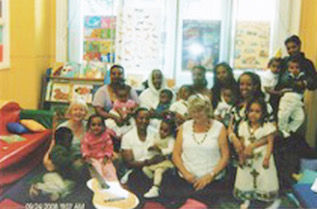


In this black and white photo you can see me looking Czech with my plaits wound round my head.

My sister and I were terrified of the old man with the dirty beard, who was in fact a kindly old Santa Claus.
Meet Our Newly Signed Author - CWLA Interview
We’re thrilled to announce that Jana Novotny Hunter has joined us at CWLA. Jana has a huge amount of author experience, with over 50 published books, and the winner of the NASEN Award for her book Read My Lips, a story exploring the communication choices of a Deaf girl. As well as awards from SCBWI, Woman’s Own, Education Resource Award (for Harper Collins Big Cat series) and nominations for many more.
Jana was born in Czechoslovakia and grew up in England. A graduate of Hornsey College of Art, she spent many years in the USA, working as a textile designer, teacher, writer and mother. We’re very excited to be working with Jana on her new book ideas. See our interview with Jana below and her tips on how to be a successful author.
• Do any of the books you write come from your own childhood?
Most of them do, along with my experiences as a mother and a teacher. For example, my book “Read My Lips” comes from having two deaf siblings and my detective mysteries come from my American husband working as a Private Eye.
• What are your top tips for writing a successful children’s book?
See through the eyes of a child. Never talk down to them (your readers know more than you think) and don’t let adults solve their problems. Know your market, and read as much as you can both of and about children’s books. Keep to the proposed length and format of your genre. Show rather than tell the action. And don’t forget to be funny, wherever possible.
• Do you think it’s important to be original or is it better to deliver what the readers and market dictate?
This is a tricky question. A fresh outlook on a hackneyed theme is important, and it’s also essential to know what entertains kids today as well as what publishers are looking for.
• How did publishing your first book change your process of writing?
I stopped writing on my kitchen table between bursts of childcare and took my writing more seriously. A proper workspace and attitude helped me to focus.
• What was an early experience where you learned that language had power?
Watching my deaf sister make the connection that the sign for an object was the same as the written and the spoken word.
• What does literary success look like to you?
To me, it’s children talking about my books in the playground. Freedom from financial constraints to enable focus on writing, is another plus, and awards don’t hurt.
• What kind of research do you do, and how long do you spend researching before beginning a book?
It varies, but I always do research, no matter what. It helps get into the theme and it builds a framework within which to work.
• What is the most difficult part of your artistic process?
Beginning it, continuing and finishing with a good ending. All creative work is hard. As Hemingway said, “There’s nothing to writing. All you do is sit down at a typewriter and open a vein.”
• Do you draw inspiration from the people around you? If yes, how?
I’m continually watching people, their quirks, their body language and their attitudes. I listen to conversations, especially to those overheard.
• What other authors are you friends with, and how do they help you become a better writer?
I have lots of friends who are writers. They inspire me and create a platform for discussion. It can be tricky when you only associate with the top of the tree, like I do, because I tend to minimise my achievements. The much-missed Jan Ormerod, was a constant spur to me, as well as Carol Thompson, Sue Porter, Andrea Bassil and many more. I shared a studio with Sue Porter and it became a meeting place for fellow authors and illustrators.
• What are common traps for aspiring writers?
A common mistake is not taking yourself or your writing seriously. A writer writes, so tell people you are a writer, and assume the mantle. Authors are writers who are published so that’s the next step. When you’ve had a few books published, not staying humble can be a pitfall. However successful you are, it can be over in a minute.
SCBWI Bologna 2008 Author - Illustrator Interview
Jana Novotny Hunter was born in Czechoslovakia and grew up in the U.K. She has written more than 50 books, including the award-winning Read My Lips. She lives by the River Thames with her dog and a piano. She was interviewed by Anita Loughrey in November 2007, as one of the speakers at the SCBWI Bologna Conference 2008 (scheduled for March 29 and March 30 in Bologna, Italy).
• Are you a writer as well as an illustrator? If so, which comes first the images or the words?
JNH: As an author, I have about fifty books published, but I have not had any of my illustrated books published yet–my first series was cancelled right at the last minute! I have illustrated for children’s TV. As an illustrator, the words usually come first.
• Do you have favourite medium you work in? If so, did the medium choose you or did you choose it? Can you elaborate?
JNH: I like to use acrylics to get a broad painterly stroke and then continue working in Photoshop. I like the strong graphic feel, and I enjoy the freedom of speed and experimentation working with technology brings.
• What are you currently working on?
JNH: A picture book concerning the anxieties and bonding of step-families.
• If you were to illustrate yourself, what would you look like?
JNH: A young, slim gazelle! (I just love fantasy, don’t you?)
• What is the hardest thing about being an author-illustrator?
JNH: My pictures don’t always live up to my expectations.
• Did you always want to be an author-illustrator?
JNH: I started off wanting to illustrate and went to art school to do just that. But the writing somehow took over.
• What were your other career choices, if any?
JNH: I was a textile designer and an art teacher. Now, I’m an editor. I love them all, but writing books has to be the best.
• Do you have a favourite children’s book that you wish you had written and/or illustrated? Why?
JNH: I wish I’d written Where the Wild Things Are. It’s such an amazing example of dealing with childhood feelings and Sendak‘s drawing skills are superb.
• How far ahead do you work? Six months? A year? Longer?
JNH: Usually about six months, depending on the format I’m working on. A chapter book is usually full-steam ahead from conception to finished draft, but a picture book can hang around in my head for years before it gels.
• Tell us about Bear Studios.
JNH: The illustrator Sue Porter and myself felt that authors and illustrators worked in such isolation, it would be wonderful to have a meeting place to discuss work in progress and share ideas. We were soooo right!
• What inspired you to write Read My Lips?
JNH: My brother and sister are both deaf, yet chose opposing ways of communication, with profound repercussions. I wanted to explore this division further in the deaf community and saw the war within a school for the deaf as a parallel to other marginalized groups that break down into minority factions.
• Can you tell us briefly a little bit about your views on the relationship between illustrations and text in picture books?
JNH: The two elements should act like different instruments exploring the same music, sometimes one playing the main theme and then the other taking over. Both are of equal importance and can work in harmony or as a reaction to one another.
• What does your work space look like?
JNH: Crammed with books and very cosy. It used to be a whole building, but since I moved to London, space is a premium.
• What’s on your wall over your desk or drawing table?
JNH: Bookshelves with dolls and toys and colourful objects, jostling with the books. And often the story sentence of the book I’m working on.
• How has your childhood influenced your illustrations and writing?
JNH: Like many people involved in children’s books, I didn’t have an idealized childhood, and I am always seeking to redress that balance by creating a secure world for children.
• What was your favourite book as a child or adolescent?
JNH: I loved Anne of Green Gables for her imagination, lack of traditional prettiness, and use of big words. I admired the way she always tried to be good and failed. I suspected she was me.
• Do you work with the television, radio, or stereo on? In cafés, nursing a half-cup of lukewarm tea, or in isolation?
JNH: I’m quite strict about silence and a good work ethic. But then I confound myself by coming up with my best ideas on the train or while I’m driving.
• Do you have a blog or website to showcase your work, and if so, how often do you blog? Do you get a lot of feedback from readers? Has it proved to be useful?
JNH: I share a lovely website with a small group of illustrators/authors which is fairly new. It’s called Wiggly Pencil. Visit it, and give me feedback, please!
• If you could be a character from one of your illustrations, who would you like to be and why?
JNH: I’d like to be Kendra, my dreamy little brown girl who dresses as a cat. She is so wild and different.
• Is it difficult to illustrate somebody else’s writing? Has it ever caused any problems?
JNH: It is, but I can answer this better the other way around and say I have sometimes been aghast at how an artist has illustrated my writing. It doesn’t help that I have such vivid pictures in my mind of how it should look. How can they ever get it right with such a premise, poor things?
Cynsational Notes
Anita Loughrey writes teacher resources and children’s non-fiction. Her books have been published by A&C Black, Hopscotch and Brilliant Publications. She also writes regular features for Writers’ Forum in the U.K. about authors and the writing industry. She recently interviewed all 32 speakers for 2008’s Bologna Conference. The SCBWI Bologna 2008 interview series is brought to you by the SCBWI Bologna Biennial Conference in conjunction with Cynsations.

Elephant Books - Meet the Author (July 2020)
Welcome to Elephant Notes . . . our periodic take on some of the ideas, issues, and news impacting parents, children, and reading.
Has it ever been a challenge to get your “Little Monster” to settle down at the end of the day? Of course! This is a universal struggle facing every parent.
Our July Author Of the Month, Jana Novotny Hunter, has written a delightful tale about a Little Monster that just won’t settle down for bed. Big Monster faces this challenge in a humorous, yet enlightening way in My Tail’s Not Tired. We can’t wait to share her strategy with you.
Ms. Hunter was born in Czechoslovakia and grew up in England. She spent many years in California but now lives with her family in a tiny village in Rutland, England. We had a chance to catch up with her and discuss our featured book this month, My Tail’s Not Tired. We hope you enjoy the interview and book!

• Jana, you have a very interesting resume. Textile designer, lecturer, editor and children’s book author. How did you come to write your first book?
When I was pregnant with my first child I was working as a teacher in Los Angeles. I was not ready to return when my baby arrived so my husband asked me what I had always dreamt of doing. “Illustrating children’s books,“ I replied dreamily. “I’ve always wanted to do that.”
“Go for it,“ my husband said, so I enrolled in classes at UCLA and discovered the writing took over.
• What parent hasn’t had to encourage their child to get rid of that last little bit of energy before settling down for bedtime. Was there a real life inspiration behind the Little Monster in My Tail’s Not Tired?
All the children I have ever known invariably maintain they are not tired even when they are drooping. The terrible irony is that they seem to gather a last spurt of super energy just before they flop. I wanted to address that and to show the parent (whom you will note is gender-less like Little Monster) has this nightly routine and has had to develop skills in dealing with it. Big Monster knows it is pointless to deny that energy and so must go with the flow.

• Big Monster is very clever encouraging Little Monster to wiggle and move about until finally not only his tail but every part of Little Monster’s body is tired and ready for bed. Do you have any professional training or guidance working with children?
I received teaching degrees in both the UK and the US for K through 12. But I was not content with that and took classes in early education too because the development of little ones fascinated me. The speed with which they develop and absorb information is so incredible. (They are also enthusiastic which was balm to my soul after teaching teenagers.) I worked in preschools, and when I returned to England I taught little ones for Sure Start, a government initiative for disadvantaged children.

• Big Monster is very patient during the all-too-familiar bedtime routine in My Tail’s Not Tired. It seems as though parents could have their child act out what Little Monster is doing as the book is being read at night. Have you received this feedback? Were you trying to find way to help parents when you wrote the book?
I have received feedback from parents who say the routine helps them get their child ready for bed in a way that does not deny them their need to get out all their wiggles. Each parent must respond to their own child’s needs, of course, so if their little one gets too wound up by these activities then it’s best to read the story with the attitude that little monster needs to calm down. Children love to see others misbehaving and it sends them to sleep with a sense of righteousness and self-confidence. All my books are an effort to help see the world from a child’s point of view while expanding the universe for the little ones.
*Ilustrator Paula Bowles and Jana at Childsplay stand in Bologna
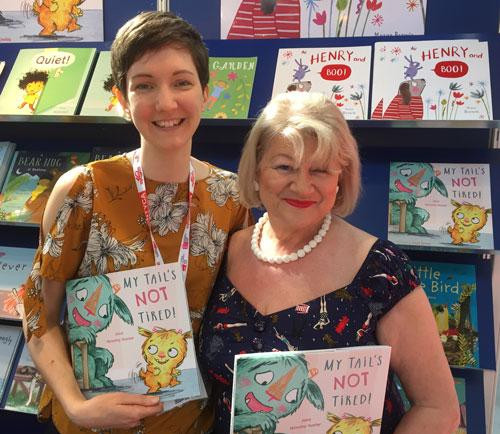
• The illustrations play so well with the story and the Little Monster is just adorable. When did you team up with the illustrator, Paula Bowles? How did you work together to come up with the illustrations for the book?
I initially illustrated a dummy for this book which I submitted to [the publisher] Childsplay. They felt the style did not fit in with their list as can often be the case. I was disappointed but these are the knocks of the publishing business, and when I saw Paula Bowles’s sketches, I knew she was perfect. There is such joy and freedom in her lively characters that you race happily through the pages with the cavorting Little Monster and the ever-patient parent. Although I never met Paula until the book was published, she understood every minutiae of what I was trying to get across. It is often better that author and illustrator don’t meet because the combustion of ideas can be very fruitful. Of course an excellent editor is as an essential and I am lucky to have brilliant ones at Childsplay.
*My son reading ‘My Tail’sNot Tired' to his son, Jaxon

• What illustration style was used for My Tail’s Not Tired?
Paula’s style is deceptively simple and quick. Her use of crayons and coloured pencils give a lively texture and her characterisations are both funny and illuminating. They show a lovely range of emotions in a few lines, which is harder to do than it looks. Her use of a white ground keeps the book fresh and light. The decisions she makes may be innate but that doesn’t mean everything is not carefully thought through.
• What is the best part about being a children’s author?
The best part is working with children. I am lucky that I still have plenty of young ones in my life, and they keep on coming! During the period when there were no babies being born in my family, I sought out friends who had children and visited schools. It is essential to keep in touch with the child’s desires. However you must appeal to children and adults at the same time as it is the adults who buy the books. The value of looking at books from babyhood has been well documented, and it matters to me to be part of that process.
Jana with 'Luna The Little Ghost' at a Rutland Farmyard

• When you look around at the current state of kids and reading, what are the biggest challenges for parents or opportunities to address?
It is imperative to get the child into books right away in order to develop a lifelong love of books. It is also important to maintain it even when the child might reach a disinterested age. Keep them reading with magazines dealing with their interests. It doesn’t matter whether you like them or not; it’s important to keep that child reading. Boys especially can be a challenge when they reach the middle years, but keep them going with funny books and non-fiction about things that fascinate them. Try reading to them again. Older kids love that. And you can get into higher reading levels because you can explain vocabulary as you go along.
• Do you have anything else in the pipeline we can look forward to reading?
I have a book that Childsplay is interested in which deals with feeling different as a newcomer. It’s about a little alien who comes is sent to school with the humans. At first he is cut adrift and overwhelmed, but it is with the power of laughter that he manages to make a connection with a little girl. Laughter is the best tool for becoming part of things. It’s a theme I addressed before in my book Hector the Spectre, who is a little ghost who wants to be funny instead of scary. Written in comic book format, it’s a great one for those disinterested boys! It is also good for those kids who are not confident readers as the book can be read with the speech bubbles alone because the pictures tell the story too. Please look at my website: www.jananovotnyhunter.uk
Thanks to Jana Hunter for sharing her background and how she approaches her work. We look forward to sharing My Tail’s Not Tired with our readers this month!
Picture Books for Older Readers
Article written for IBBY - International books for the Young - Jana Novotny Hunter
A picture book tells a long, often complex, multi-layered story with a few carefully selected words and images, which distil, heighten, expand and illuminate the tale. How can this process ever be easy, and why has the picture book been assumed to be within the confines of younger readers? To be able to extract the salient points of a long story into a concise, cohesive version entails numerous skills including a highly sophisticated leap of understanding. Moreover, the conviction that expertise in decoding the printed word enables the reader to dispense with the crutch of pictures, is based on a fundamental misreading of the way we process information. In a culture rich in visual imagery is it any wonder that picture books are in fact enjoyed by all ages?
In Not So Simple Picture Books, Baddeley and Eddershaw (1994) demonstrate how related picture books can be used to develop the older reader’s response to literature by finding similarities in psychological behaviour. Through comparing and contrasting linked books, they showed how readers gain deeper insights into emotions and experiences, and develop verbal skills as well as sensitivity. Rather than the conventional way of connecting a concrete theme, abstract concepts such as loss were examined.
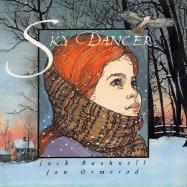
The late Jan Ormerod, a consummate illustrator, could convey deep emotions in her work. In her picture book for older readers, Sky Dancer (text Jack Bushnell, 1996), the absence of a parent is dealt with in words and pictures, which together connote such a profound sense of loss and longing that the mother’s demise need never be referred to directly. Instead, the symbolism of a powerful hawk allows the reader to understand that the girl’s lost mother watches over and comforts her. (It is worth noting that this book was never published in Britain where reading, and by implication the need for pictures, start younger.)
A similar sense of bereavement pervades Shirley Hughes’ Dogger (2009) where the disappearance of a toy creates the same level of anxiety.
When readers make connections between these quite different approaches to loss, respect for the powerful emotions in the smallest child can be gained, and a deeper sensitivity and wisdom developed. The ability to articulate such findings is further enrichment to the experience.
Abstract concepts such as time can also be explored, since picture books can bend and stretch time to create parallel worlds. In Come Away from the Water, Shirley (1977), John Burningham uses tangential text alongside images that tell an entirely different story. On a visit to the seaside, Mum and Dad park themselves in deck chairs, oblivious to everything but their own bland world, while Shirley gets cracking with her own pirate adventure. Come Away from the Water, Shirley, exhorts her mother, but Shirley, used to such curtailment of freedom, is exercising her bold imagination. Burningham’s juxtaposition of both sides of the story, where each ignores the other, creates a tension that is both hilarious and ironic. The admonitions of dreary parents alongside the colourful actions of their daughter, creates a secretive bond with the audience and a respect for their understanding.
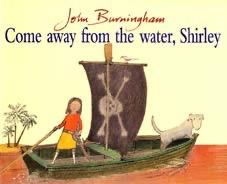
Such a book requires an ability to see time running concurrently, while at different rates. It also necessitates the maturity to see adults objectively, even critically. And yet, in the past the enjoyment of the picture book mirrored the age level of new readers, so only in countries where children start reading later were picture books appreciated longer. This new level of sophistication challenges such strictures, ensuring that older readers can feel justly proud of the maturity required to fully comprehend these books.
A picture book demands that the reader inhabit its world, and such worlds are as varied as the authors–illustrators themselves and the culture from which they originate. The reader can make connections with other worlds, and this process is not limited to books, but to all the arts. Filmmakers like Tarantino make allusions to the familiar icons of a genre in the same way that Anthony Browne does in alluding to famous works of art. This use of familiar icons, phrases or sounds expects a background knowledge that only the well versed can make, but questioning these allusions can provoke can enlighten and educate the reader. Picture books can prepare readers for the challenge that the arts make in referencing metaphors and sounds. In this way, they are a portal to greater understanding as well as preparation for a vastly complex world.
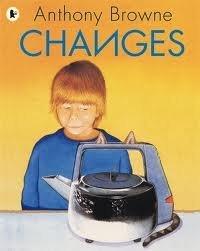
Symbolism and surrealism can be found in Changes (1990), where Anthony Browne juxtaposes everyday language with a fantastic environment, contrasting the word with the images tangentially. The prosaic language and pedestrian detail used, creates a tension between that and the symbolic illusions of the picture, as transformations occur like the kettle changing into a cat. Here hard becomes soft, cold becomes warm and dead becomes alive as the hero anticipates changes. We are observers of the strange sphere that he inhabits, fully aware that this is a book. As the pictures show an increasingly bizarre metamorphism, the calm words show no fear. There are symbolic clues to the hinted changes – the painting of the Madonna and Child, a family photograph and a bird flying who has laid four eggs. But to mirror the quiet contemplative language, all action is stilled in a photographic way – frozen in time. Changes portrays the unease and curiosity of the only child contemplating a sibling in a most original and erudite way.
‘Literature is an institution that lives by exposing and criticizing its own limits, by testing what will happen if one writes differently’ (Culler, 1997: 46). In picture books enjoyed by older readers, similar limits have been explored, both in the construct of the book and the visual imagery that works within it. Instead of being the objective viewer distanced from the book, authors–illustrators like Jon Scieszka, Lane Smith and Lauren Child bring the reader into the book by playing with its very nature. They employ a sophisticated dialogue between reader and originator, while continuing to adhere to conventions such as size and page extent, which act as a platform from which rules may be exploded.
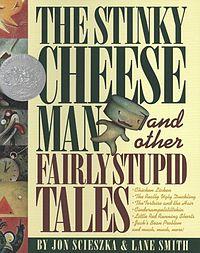
In Jon Scieszka and Lane Smith’s The Stinky Cheese Man and Other Fairly Stupid Tales (1992), the formal rules surrounding the paradigm of a book are challenged when the little red hen imposes herself on the endpapers and the character of the designer butts in with, ‘Listen Hen – forget the wheat. Here comes the Title Page.’ Expanding on this clever naughtiness the ‘Table of Contents’ becomes an essential part of the storytelling so that not only have boundaries been crossed, they are now weaving into one another in an inextricable way. The play on words where the ‘contents table’ is heavy enough to squash the characters is visually and literally funny as is the voice of the giant later on who squeezes the type in his threat to squeeze Jack. Dialogue that is both confrontational and anarchic appeals to knowing kids who are used to hearing the way adults and children interact, so this book appeals on many levels. These are not fairy tales but ‘fairly stupid tales’, just right for the age when puns are understood and enjoyed. Children used to new ways of telling a story in computer games, television, film and advertising can fully appreciate such anarchy.
The content of the book is further played within Who’s Afraid of the Big Bad Book? (2003) by Lauren Child, whose original, quirky style is matched by a title that twists a well-known phrase into something original. This edgy and funny book continues in subversive vein throughout, literally turning the picture book upside down. In the first spread the illustrator is brought to the attention of the reader, so not only are the formal constructs like tables of contents present, there is now an illustrator putting her oar in! The reader identifies with the hero, Herb, who is also a reader of the book, and a more subversive reader you couldn’t wish to meet. Using scissors, Herb cuts out Prince Charming and the queen’s throne from the book and draws a moustache on the royal lady. He then pastes on that most modern communications device – a telephone (which is used to good effect in this period story). There is Herb himself entering into the picture and directly interacting with the characters and the physical construct of the book – cutting holes in pages to leap through and drawing doors from which to escape. What a delight!
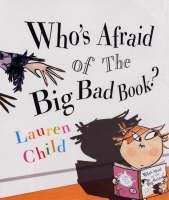
‘The work is not something objective ... but is the experience of the reader’ (Culler, 1997: 129). In this way, picture books serve the needs of a hugely varying audience. Maurice Sendak’s Where the Wild Things Are (1963) is a story that can be simply interpreted as a boy’s fantasy after being naughty, yet on a much deeper level it unveils the confrontation of feelings in a richly symbolic series of ideas. This ground- breaking book deals with emotion on both a surface and a subliminal level, and was a response to current developments in psychoanalysis. Max’s temper tantrum is told through a journey into a fantasy world, where the wild things (his own angry feelings) create a tumultuous rumpus. The fact that these monsters may also refer to Max’s strict parent makes it all the more dramatic when the monsters are overwhelmed and tamed by the boy. Sendak gives the power back to children made afraid by the force of their feelings and the adults who chastise them. Sendak explores anger in a symbolic way by playing with the layout of text and image to expand time, place and fantasy. By subtly enlarging the size and framing of the image on each subsequent spread, we understand how the real world is being left behind and it is only by revisiting the original formal layout that the return to reality is announced. Time, which has expanded, now snaps back when we’re told Max’s supper ‘was still hot’. With few words but enigmatic images, Sendak is emphasising that while Max’s fantasy took more than a year and a day, real time was only a few minutes long.
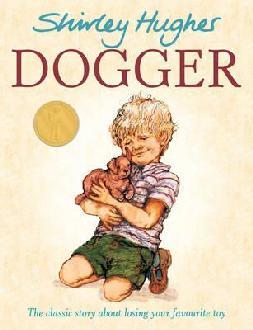

Sendak’s great work is a fitting place to end, as it is a composite example of the multifaceted and insightful journey a picture book can take. For this medium engages in a highly creative process by which the reader attempts to connect the disconnected environment in which we live and to reconcile his/her place in it. The reader must then sift down the information and store it in a way that helps him/her understand and confront the expanding world in which he/she is growing up, whilst being entertained and engaged throughout. No mean feat in a book, a mere 32 pages long.
Works Cited
Pam Baddeley and Chris Eddershaw (1994) Not So Simple Picture Books: Developing Responses to Literature with 4–12 Year Olds. Stoke on Trent: Trentham Books.
Anthony Browne (1990) Changes. London: McRae.
John Burningham (1977) Come Away from the Water, Shirley. London: Cape.
Lauren Child (2003) Who’s Afraid of the Big Bad Book?. London: Hodder Children’s Books.
Jonathan Culler (1997) Literary Theory: A Very Short Introduction. Oxford University Press.
Shirley Hughes (2009) Dogger. London: Red Fox Books.
Jan Ormerod (1996) Sky Dancer. London: HarperCollins.
Maurice Sendak (1963) Where the Wild Things Are. New York: Harper & Row.
Jon Scieszka and Lane Smith (1992) The Stinky Cheese Man and Other Fairly Stupid Tales. London: Viking.